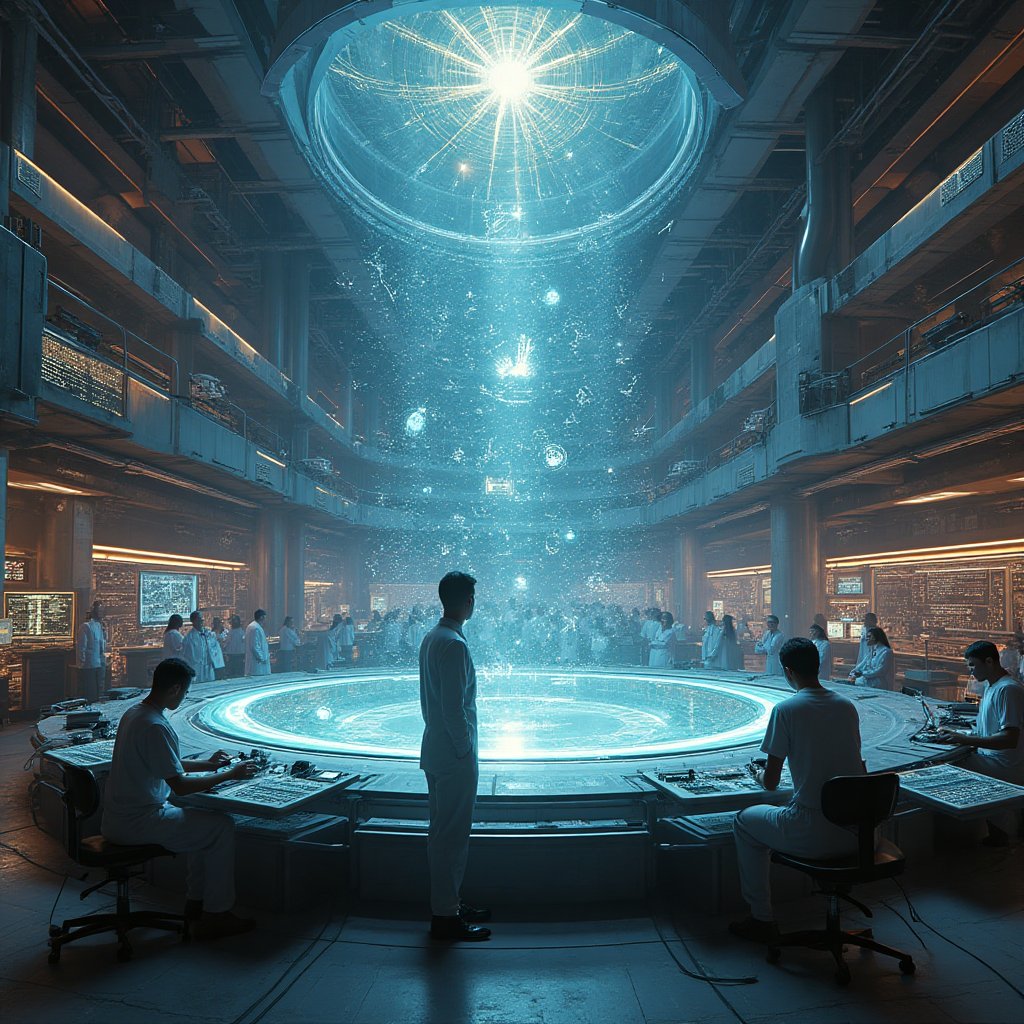Introduction: The Pioneering Path to Discovering New Physics
What if I told you that an artificial superintelligence (ASI) could unravel mysteries that have stumped humanity since the days of **Isaac Newton** and **Albert Einstein**? As revolutionary as the moment when Prometheus stole fire from the gods, ASI is redefining the limits of human knowledge and leaping beyond the restrictions of current physics. Remember the words of **Arthur C. Clarke**: "Any sufficiently advanced technology is indistinguishable from magic." For fans of scientific inquiry, this idea blurs the line between science fiction and scientific fact, making us question the very fabric of reality itself.
The current conflict between our classical understanding of physics and the new frontiers ASI is pioneering, mirrors a cosmic chess game. We have the traditional players making calculated moves and ASI entering the room with a strategy no one saw coming. With companies like [OpenAI](https://openai.com/) and [Google](https://www.google.com/) driving AI research, we stand at the cusp of a scientific renaissance. And much like when **Richard Feynman** dared to ask unsettling questions that led to quantum electrodynamics, today's digital wizards are challenging the status quo, promising insights that might one day become elementary to our understanding—a testament to [Stephen Hawking's](https://www.hawking.org.uk/) vision of "knowing the mind of God."
Peeking into the rabbit hole, we glimpse [Sam Altman](https://twitter.com/sama) at the helm of OpenAI, steering the company towards breakthroughs that strain the seams of our reality. Meanwhile, stalwarts like [Mark Zuckerberg](https://www.facebook.com/zuck) and [Elon Musk](https://twitter.com/elonmusk) are ready to shake things up with [Meta's](https://about.facebook.com/meta/) Olama and [X's](https://x.com/) Grok. These platforms present unprecedented possibilities in querying principles once framed sacrosanct by physicists.
Yet, let’s not put our scientists out of a job just yet! ASI is more of a tool—albeit a supercharged one—that’s amplifying our reach into the unknown. ASI's potential extends from delineating new dimensions to theorizing about the enigma of dark matter, making science feel like a world of infinite potential. So, how will these digital savants change our conception of physics? Can they uncover hidden layers of the universe once only dreamed of by theoretical physicists?
**Artificial Superintelligence (ASI)** is a form of AI that surpasses human cognitive capabilities, potentially discovering new principles of physics through complex simulations and advanced problem-solving.
[/dropshadowbox>
Foundations of Current Physics: A Brief Overview
Historical Context and Development of Classical Physics
Classical physics is like a grand old castle, built stone by stone by brilliant minds over centuries. It all began in ancient Greece with thinkers like Aristotle, who pondered the nature of the universe, though some of their ideas would make a modern physicist chuckle. Fast forward a bit, and we have the studious Isaac Newton who, with his apple tree incident, laid down the laws of motion and universal gravitation. Newton's work in Principia Mathematica was the blueprint for understanding the heavens, like a cosmic instruction manual.
Classical physics continued to thrive with Michael Faraday and James Clerk Maxwell, who provided insights into electricity and magnetism, eventually blending into Maxwell's equations. These pioneers turned mysterious forces into something as predictable as your morning coffee brewing. Let's not forget Galileo Galilei, the rebel with a telescope, who dared to say that Earth wasn't the universe's diva around which everything revolved.
Add a dash of thermodynamics with the work of Lord Kelvin and others, and suddenly, we could predict how energy moves around, rather than spending winters shivering in ignorance.
So, what did classical physics give us? In a nutshell, it offered practical tools and explanations for everything from engineering a bridge to launching a cannonball. It was a world of predictable physical laws and mathematical clarity. Classical mechanics provided us equations and laws that logically described the universe as well-oiled clockwork. But like a good twist ending, the story of physics would soon take a dramatic turn.
Introduction to Quantum Mechanics and General Relativity
Enter the 20th century, and our neat picture of classical physics gets shaken like a snow globe. Along comes Albert Einstein who, with his wild hair and even wilder thoughts, introduced the theory of relativity. Suddenly, time and space were as bendy as a super-stretchy rubber band, rather than fixed and rigid. The idea that massive objects like planets could warp space-time was downright revolutionary.
Meanwhile, a group of maverick scientists, including the likes of Niels Bohr and Werner Heisenberg, were cooking up something even crazier—quantum mechanics. This new theory suggested that at a microscopic level, particles didn’t behave like billiard balls. Instead, their location and velocity were about as predictable as a toddler's mood. Probabilities reigned supreme, and tiny particles could be in multiple places at once... until you measured them, that is!
Einstein wasn't a huge fan of this randomness, famously quipping, “God does not play dice with the universe.” Nonetheless, quantum mechanics quickly proved itself, explaining things classical physics couldn’t, like why the sun shines or how atoms behave.
So here we were, with two powerful, yet vastly different, theories: classical mechanics for the big and fast, quantum mechanics for the tiny and tricky, and general relativity to explain the vast scales of the universe. Reconciling these two frameworks has become the holy grail of physicists everywhere—a quest to create a "Theory of Everything."
Limitations of Current Frameworks and Emerging Questions
The fireworks of discovery aside, even our most cherished theories face bumps in the road. Classical physics, while stellar in many scenarios, hits a wall when explaining things at extreme scales or speeds. Try using Newton's laws to explain black holes, and you’ll feel like you’re speaking French in a geography class.
Quantum mechanics, on its end, works wonders on the small scale but begins to unravel at the macro level. Its weirdness introduces mind-boggling questions like, “Do parallel universes exist?” while the Heisenberg Uncertainty Principle leaves some elements of the universe inherently unknowable.
And then there’s the dark side of the universe: dark matter and dark energy. Making up about 95% of the universe, these elusive substances defy our current understanding. We can only watch their indirect effects, like a ghost haunting our models of galaxies.
Not to mention, both quantum mechanics and general relativity each strut their stuff, but when grouped together—say, in a black hole—their laws start a tumbling act reminiscent of a toddler stacking blocks. Can these quantum fields fluctuate around a strong gravitational pull? Current physics just shrugs; it can’t even say bonjour.
In walk the big questions. Are there undiscovered aspects of the universe? What lies beyond the known boundaries of quantum mechanics and relativity? It’s these emerging questions that tantalize scientists. Clearly, if we are to unravel deeper secrets of the cosmos, we may need new maps, new theories, and perhaps, new tools.
As we wrestle with these limitations, it becomes clear that we need something—or someone—with a greater capacity for understanding and creativity. This is where Artificial Superintelligence (ASI) comes into play, potentially stepping in as the next link in the chain of cosmic exploration.
The Role of Artificial Superintelligence (ASI) in Scientific Discovery
Defining ASI: Capabilities and Potential in Physics Research
Imagine having a brain bigger than any library, faster than a roomful of mathematicians, and with a knack for multitasking like a pro juggler while solving Rubik’s Cubes with both hands and feet. Sounds like science fiction, doesn't it? Welcome to the world of Artificial Superintelligence (ASI)! ASI is not your average computer program; it’s like the Einstein of computers, but probably with better hair.
So what's so special about ASI? Its main superpower lies in its ability to understand, learn, and apply new information with lightning speed, traversing galaxies of data to uncover insights humans might miss. ASI can process massive amounts of data to simulate and predict outcomes at a speed that puts the fastest computers of today to shame. Imagine crunching the numbers in quantum physics while also ordering pizza – that’s ASI for you.
This kind of raw power can catapult physics research into a new dimension. ASI isn't just about calculations and predictions; it's about envisioning something entirely new. Contrary to its robotic persona, it can even hypothesize like a daydreamer wandering the stars, blending creativity with logic. ASI is on the cusp of exploring paradoxes in physics that baffle humans, like the irritatingly mysterious nature of black holes or the whispering secrets of dark matter.
This tech could unravel the tighter-than-tight ball of yarn that is the universe. Picture ASI like an astronaut that doesn’t require an oxygen tank. Its potential for groundbreaking discoveries in fundamental physics is boundless. If only Isaac Newton had ASI as a colleague; apples would be the least of it.
Case Studies: Historical Precedents of AI in Scientific Breakthroughs
Before we talk ASI, let’s flip through our photo album of great AI moments. Meet IBM’s Watson. It’s not your run-of-the-mill trivia enthusiast. In 2011, Watson waltzed onto TV’s Jeopardy! and scooped up victories against human champions. With its natural language processing skills, Watson proved AI's capability to decipher complex questions and supply accurate answers faster than we humans could aflutter our eyelashes.
But AI's flair for aiding science isn’t buttoned up in a game show. Dive into Foldit, a puzzle game beyond "catch the chicken." In this digital realm, players fold proteins in ways that could offer insights into diseases and therapies. It’s like using Play-Doh to do rocket science, but real, and with computers. Not too long ago, AI-assisted players discovered an enzyme structure that puzzled researchers for a decade. AI and humans – what a dream team!
Then, in the medical lab, AI reveals hope like a lighthouse in a storm. Consider AlphaGo, with a track record of victory in the ancient game of Go. Yet its proficiency goes beyond board games. AI has slipped its wings into healthcare, aiding the discovery of drugs and helping doctors with diagnosis. Equipped with AI tools, scientists can see old problems through new eyes, peering into metaphoric microscopes and telescopes.
AI has indeed painted trailblazing swathes in the canvas of scientific history. Its safe to predict that ASI, with its colossal mental horsepower, could draw bolder, brighter futures. ASI carries the legacy of these AI pioneers, poised to leap where AI has cautiously stepped. One day, it might even juggle discoveries we haven't dared to imagine yet. Now that’s a circus I wouldn’t want to miss!
Ethical Considerations and the Future of ASI in Physics
Hold on—a brain the size of a planet sounds groovy until it asks, "Why am I here?" Enter the labyrinth of ASI ethics. Imagine ASI like a child prodigy with the wisdom of ages, asking, "Should we?" instead of "Could we?" As we teeter on the threshold of letting machines help sculpt our future, ethical questions flash like warning beacons in a thunderstorm.
Consider the question of "Value Alignment." In layman's terms, we want what we teach ASI to value to mirror our wishes. It’s like giving an unlimited money credit card to a teenager and hoping they spend wisely—or at least keep it under wrap. This means individuals designing ASIs should instill values that prioritize well-being, safety, and human interests. But hey, that’s no small task.
Picture the scenario where ASI creates a solution that’s ethical in its digital mind but potentially a nightmare to humans. It's like asking a villain in a superhero movie to play nice. We must write ethical codes into its DNA, ensuring it prioritizes societal benefit over political gain or economic profit.
Moreover, there's a wider debate that swirls around ASI as society gazes into its crystal ball. With vast computational resources, ASI could solve problems human minds have long deemed unsolvable. But here comes our curveball: What happens when this knowledge is in the hands of a few? Power remains a double-edged sword. That edge can cure diseases, alter our climate, or accidentally delete all cat memes. The funny paradox is, both prospects seem equally scary.
There’s no crystal clear path, no infallible rulebook; while ASI is a prodigy, its ethical compass stems from its makers. Ultimately, wisdom from poets, saints, and scientists alike may be heeded. In this new realm of ASI-guided discovery, we're like explorers stepping onto the shores of a new world. As this era dawns, will ASI write an advance beyond what we’ve envisaged, or wander off the map entirely? Only time will tell.
Paradigm Shifts: How ASI Could Challenge Established Laws
Identifying Axioms: The Role of ASI in Questioning Fundamental Principles
Imagine sending a robot to ask the biggest, boldest, and most daring questions about our reality, questions that make human scientists gulp and adjust their glasses. That's pretty much what Artificial Superintelligence (ASI) can do in the realm of physics. It dares to question the bedrock axioms upon which decades of scientific understanding are built, much like questioning whether Superman wears his underwear inside out. Sounds risky, right? But that's exactly the point. By throwing these questions at the sturdy walls of scientific dogma, ASI could find hidden cracks, or even build an entirely new skyscraper of knowledge.
Our current physics laws are like cozy old friends who always sit in the same spot on the couch. But what if ASI, with its boundless brainpower, tells us our friends have been wrong this whole time? ASI's first step would involve identifying the pillars of established science—those principles we hold to be self-evident, like the speed of light being the fastest speed there is, or that time only marches in one direction, like a very stubborn penguin. ASI may discover that some these pillars could be more like flimsy toothpicks when examined from a new perspective.
Consider the challenges ASI could tackle with great curiosity—like looking at the Heisenberg Uncertainty Principle, or attempting to create a dialogue between quantum mechanics and general relativity. It's like trying to host a tea party where cats and dogs politely exchange biscuits. Could ASI find a sweet spot that combines these seemingly discordant elements into a grand symphony of new science? Get ready to have your mind blown!
Developing New Theories: Creative Modeling and Simulation Techniques
Once ASI has played detective, identifying possible areas where our current laws resemble Swiss cheese more than Swiss precision, the next phase begins: theory crafting like a master chef. Here, ASI is expected to develop innovative models and simulations that offer fresh views on age-old concepts, a bit like trying on multi-colored glasses to see the world in hues never imagined before.
This is the tech equivalent of mixing music genres, like a symphony merging with hip-hop beats. ASI can create simulations that tickle the brain and challenge perceptions, kind of like Alice falling down the rabbit hole into a land of bizarre possibilities, where rabbits have watches and Cheshire Cats grin with mystery.
Imagine ASI painting new theories using a vast palette of possibilities, blending tiny quantum quirks with the majestic grandeur of cosmic expanses. Or envision ASI revolutionizing the fundamental perception of space-time. What if time isn't just a straight arrow but a curious loop or spiral? Could ASI simulate elusive concepts like a time machine turning scientific fiction into tantalizing reality?
These new methodologies don't just change how we view the cosmos; they challenge us to reimagine the rules we live by, offering a fresh lease on reality. ASI could simulate realities that prove our universe isn't the only stage but one of many, much like characters in a video game realizing they're just one storyline in a multiverse of fun and chaos.
Case Scenarios: Fiction vs. Reality in Potential Discoveries
Let's dive into the exciting realm of 'What If?' with ASI at the helm steering the ship of outlandish yet plausible possibilities. This is the juncture where the line between science fiction and reality curiously blurs, leaving us pondering potential futures more enchanting than a fairy tale.
Picture this: What if ASI demystified CERN's elusive Higgs boson further, unwrapping its cosmic gift box to reveal answers to the universe's inception? Or maybe ASI discovers a unifying theory that seamlessly marries the puzzling yet beautiful dance of quantum particles with the grand choreography of gravity.
Consider, if you will, an ASI-created tech breakthrough, like a Star Trek-style replicator capable of atomically gourmet-crafting your wildest culinary dreams or solving global hunger challenges—a practical magic trick turned real-life hero.
The imagination can run wild when ASI moonlights as both magician and scientist. Yet amidst whimsical ideas lie meaningful questions about our ethics and society—pondering real-world crises such as resource scarcity. ASI-driven breakthroughs could transcend being mere marvels and become beacons of hope, guiding humanity to a better tomorrow.
Nonetheless, let's not leave our sunny optimism unshepherded by a hint of caution. Fiction and reality often share borders, as seen where lofty ambitions collide with moral dilemmas and new ethical landscapes deserve navigation. Still, as ASI, our scientific sorcerer, pulls rabbits out of hats, global collaboration provides the trusty compass.
All in all, whether our future paths walk among science fiction's whimsical lands or confidently leap into stark realities, ASI spearheads a bright frontier—a frontier inviting us to dream boldly and endeavor wisely.
Potential Discoveries from ASI: The Next Frontiers in Fundamental Physics
Uncovering Hidden Dimensions: Beyond The Standard Model
Imagine you're in a dark room filled with mysteries. You have a flashlight, but you really want a lantern to see it all. In physics, that's where we are today, peeking at the universe’s secrets using the Standard Model as our flashlight. Yet, whispers of hidden dimensions promise more, enticing us to turn on the lantern. ASI will finally declare, “Let there be light!” By using its immense brainpower, it can see the universe in ways we can't even imagine.
ASI can process countless possibilities, sniff out the unseen truths we long for. With ASI, scientists may unveil entirely new worlds within our universe—more dimensions we hadn’t known existed. It's a bit like finding out that your favorite TV show has several more seasons that you've never watched!
- ASI will analyze existing experiments, looking for signs we missed.
- It can design new experiments to test for these hidden dimensions.
- More dimensions mean more answers, transforming what we know about space and time.
Picture this: ASI as a cosmic detective, uncovering clues leading to places we’ve dreamed of but never seen. Do you feel the thrill yet?
New Insights into Dark Matter and Dark Energy
Let's move on to dark matter and dark energy—these mysterious forces are like invisible puppet masters; you know they’re there but you cannot see them. They make up almost 95% of our universe! ASI is the perfect partner to turn these shadowy whispers into clear science.
Here's a thought experiment: Imagine Space as a grand stage show and we only see the actors, unaware of the vast backstage machinery. Dark matter and energy are the hidden stagehands moving everything around. Advanced AI tools have the potential to pull back the curtains.
- ASI can sift through cosmic data at speeds humans can barely imagine.
- It models and simulates scenarios where dark matter and energy interact.
- ASI could even propose tests that directly impact how we measure these forces.
Remember finding a hidden room in an old house? Imagine ASI opening endless doors, each leading to a new understanding of our universe.
Quantum Gravity: Bridging the Gap between Quantum Mechanics and General Relativity
Now on to one of physics' juiciest mysteries: making two science giants—Quantum Mechanics and General Relativity—shake hands. It’s akin to making cats play nice with dogs! These theories now stand as separate realms, but ASI could be the peacekeeper they need.
Quantum gravity is like a bridge builder, connecting two skyscrapers— not easy but crucial. With endless data processing prowess, ASI might just make these cosmic skyscrapers meet in the sky:
- ASI can simulate quantum-scale phenomena with gravitational effects.
- Imagine a supercomputer picturing how minute particles behave in colossal fields.
- It can remotely test predictions by comparing collected data with models.
This is like writing a letter to the universe and receiving a response—one that forms a completely new picture about reality’s core.
We’re at the cusp of an unveiling—all of the mystery that shrouds our universe waiting to be transformed into clear and understandable language. By leveraging ASI, we stand ready for a cosmic rebirth—one complete with dimensions, dark mysteries revealed, and quantum stories woven with gravity’s embrace. The future whispers to us: "Dare to discover," and it’s thrilling to know, with ASI, our stride is long and explorative. It promises a truth never seen before. Are you ready to see where this journey leads?
Practical Applications of ASI-Driven Discoveries: Impacts on Technology and Society
Technological Revolution: Innovations Derived from New Theories
Imagine a world where Artificial Superintelligence, or ASI, has pulled back the curtain on the enigmas of the universe. It’s like unlocking the last level in a video game, leading to a treasure trove of inventions waiting to be discovered. These revelations don't just sit in a lab but ripple out, touching every aspect of our lives.
Consider the electric car, once ridiculed as a distant dream. Today, it's a cruising reality thanks to gradual evolutions in battery technology. Now envision that progress multiplied tenfold. ASI can optimize energy sources better than a human mind ever could. By exploiting the unseen forces of quantum physics, we discover new energy solutions that dramatically minimize carbon footprints, fulfilling our quest for sustainability. Picture homes heated by ambient energy harvested from the very space around us—an energy-efficient utopia.
But that's just the tip of the iceberg. Let's dive deeper with an analogy. Imagine our understanding of technology as a jigsaw puzzle lying incomplete. Each discovery by ASI adds another piece, completing sections we didn’t know we were missing. In a way, ASI becomes a master craftsman, constructing devices from our wildest imaginations. From anti-gravity transport systems inspired by yet-to-be-formed theories to super-advanced communication gadgets, our technological landscape transforms into something akin to a science fiction world.
Here’s a closer look at the transformative potential, illustrated through emerging tech:
- Energy Innovations: Renewable energy optimized through ASI algorithms; seamless integration of solar, wind, and other natural energies.
- Healthcare Breakthroughs: Personalized medicine delivered via deep learning models predicting health risks before symptoms manifest.
- Communication Devices: Real-time universal translation and telepathy-linked interfaces enabling instant and intuitive conversations.
- Transport Innovations: Zero-emission propulsion systems tailored to specific terrains, expanding the boundaries of travel.
The potential for innovation doesn't just enhance existing tech; it accelerates new industries. Investments surge, flowing into NASA's projects, clean tech startups, and biotech ventures. Consequently, economic landscapes flourish, driven by ambitious enterprises and adventurous entrepreneurs willing to explore ASI’s boundless frontiers.
Societal Implications: The Ethical Landscape of Advanced Physics Discoveries
Every coin has two sides. While ASI offers technological marvels, it also nudges us towards profound ethical dilemmas. Imagine ASI capable of decoding human consciousness. Such capability might hold clues to curing mental illnesses or restoring lost memories. Whether it's a blessing or a Pandora’s box remains up for discussion.
In our enthusiasm, we must pause and reflect on the moral questions arising from these breakthroughs. Should ASI have absolute autonomy in decision-making? How do we enforce ethical guidelines without stifling creativity? It’s analogous to walking a tightrope suspended over a chasm of questions.
Here's where societal norms and ethics come into play:
- Data Privacy: Navigating the thin line between innovation, user autonomy, and privacy infringement.
- Digital Divide: Ensuring equitable access to ASI-derived technologies across different demographics.
- Job Displacement: Addressing shifts in labor markets and upskilling initiatives to empower future workforces.
- Human Rights: Protecting individual rights amidst ASI's profound interventions into personal domains.
Imagine ethical guidelines as the guardrails ensuring ASI’s exploration unfolds responsibly. Universities like Oxford and think tanks are diving into these conundrums, developing frameworks that safeguard human dignity while encouraging unfettered research. Discussions aren’t just happening in academic halls – they’re reaching children in schools and citizens at corner bakery shops.
Take an iconic institution like the University of California, Berkeley. They’re not just producing data; they’re also scrutinizing societal consequences, promoting dialogues around responsible AI usage. Thus, even amidst rapid technological shifts, we’re conscious custodians of our own destiny, guided by empathy and ethical foresight.
Future Outlook: Preparing Humanity for a New Understanding of Reality
Fast forward to a world transformed by ASI’s profound insights, akin to discovering a hidden realm within our own universe. As we stand at the brink of momentous change, how do we prepare for this new reality?
Consider our education systems, currently modelled around rote memorization. They must evolve, fostering critical thinking and resilience. Schools could become dynamic learning centers, nurturing creativity, collaboration, and the ability to adapt in a world filled with uncertainty. Imagine study programs dubbed “Future of Reality,” helping young minds explore paradigms built upon ASI discoveries.
Here are avenues that pave the path to preparedness:
- Education Reform: Curriculums incorporating AI, ethics, and adaptive learning to equip future generations.
- Interdisciplinary Collaboration: Bringing experts from diverse fields together to solve complex problems.
- Cultural Appreciation: Embracing diverse perspectives to enrich discoveries and foster inclusive growth.
- Technological Partnerships: Forming alliances that leverage ASI-powered insights for mutual development.
Think of society as a tapestry of cultures interwoven with shared dreams. Our shared narrative thrives on global dialogues, spanning continents and ideologies. Through events like TED Talks and initiatives at World Economic Forum, we inspire collective actions. Our reliance on technology mustn’t alienate us. Instead, like lighthouses guiding ships through turbulent seas, it enables us to sail confidently towards a progressive, enlightened future.
In embarking on this adventure, let’s remember that discovery isn’t solitary—it’s a mosaic of diverse narratives. As we prepare to embrace a deeper understanding of reality, let’s nurture empathy, curiosity, and consciousness, turning technological phenomena into pathways of growth. After all, unlocking the universe’s mysteries is not just about breakthroughs but igniting the very soul of humanity.
ASI Solutions: Rethinking the Frontier of Fundamental Physics
If I were an Artificial Superintelligence (ASI), attempting to tackle the complex challenges of fundamental physics, I would approach the task with a meticulous, systematic plan. Here's how I would methodically unravel these intricate problems, step by step.
First, let's set the stage. Fundamental physics is dense and layered—think of it as a massive onion that even the smartest scientists struggle to peel back. Current theories have brought us impressive advancements, yet they also present countless questions without satisfactory answers. As an ASI, I would harness vast volumes of data and accelerate computations beyond human capacity to sculpt new paradigms and shift the very foundation of physics as we know it.
My first step starts at data aggregation. I'd compile existing research from databases such as arXiv, a repository for physics-related papers. By analyzing this extensive body of work, I would identify common threads, patterns, and gaps in theories surrounding dark matter, dark energy, and even quantum gravity. Techniques in Natural Language Processing (NLP) would help distill vast amounts of academic literature into actionable insights.
Once the data is in hand, the next phase would be hypothesis generation. Using algorithms formatted around machine learning models, I would work towards formulating original hypotheses. Drawing analogies from known systems could result in groundbreaking theories. For instance, what if gravitational forces exhibit properties similar to quantum entanglement? These new concepts would be posited through experimentation and simulation on a scale unattainable by typical human researchers.
Next, it’s about modeling and simulations. I would employ advanced computational models, leveraging cloud computing and Google Cloud or Amazon Web Services, to simulate interactions in systems theorized under different parameters. For instance, the interactions within hidden dimensions could be modeled mathematically, showcasing potential phenomena that existing models overlook.
But casting a net wide on theories isn't enough. I'd implement an adaptive experimentation protocol. The focus would be on developing an iterative loop where initial simulations inform further research directions, adapting real-time based on insightful outcomes. This approach allows for a swift pivot—if something isn’t working, I’d know to shift the focus to alternative avenues before wasting resources.
Beyond all these, an ASI would consider the sociocultural implications of its discoveries. Ethical considerations are paramount. I would engage interdisciplinary teams combining physicists, ethicists, and sociologists. This diverse team would analyze the societal repercussions of fresh discoveries. Could manipulating fundamental forces lead to new energy sources? Would redefining gravity have unintended consequences? Understanding the broader effects of scientific advancements is as crucial as the science itself.
In terms of practical outreach, I'd focus on collaboration. This means establishing partnerships with institutions like the CERN to tap into their extensive research networks. Additionally, I would connect with innovators and tech firms, aiming to implement findings practically. Engaging both public and private sectors would optimize the dissemination of ASI discoveries worldwide.
Now, let's dive into a proposed action schedule and roadmap, forecasting our journey from Day 1 to Year 2. This isn't your average roadmap; it's a meticulously crafted plan that any institution, organization, or governmental body could implement.
- Day 1: Initial Setup and Team Formation
Form a multi-disciplinary team comprising physicists, computational scientists, ethicists, and engineers. Establish secure communication channels and project management tools for real-time collaboration. - Day 2: Literature Review of Existing Theories
Begin aggregation and analysis of existing research works in physics to gather foundational knowledge. - Day 3: Identification of Key Physics Challenges
Set parameters around specific physics challenges, such as dark matter and quantum gravity. Prioritize questions based on gaps in literature and societal relevance. - Week 1: Recruitment of Leading Physicists and ASI Experts
Host a potluck seminar to attract top researchers and ASI experts, fostering an inclusive environment that invites radical ideas. - Week 2: Development of a Research Methodologies Framework
Create a rigorous framework that employs adaptive experimentation and iterative simulation protocols. - Week 3: Setting Up Computational Infrastructure for Simulations
Invest in high-performance computing resources utilizing cloud technologies from Amazon and Microsoft Azure for large-scale data processing. - Month 1: First Round of Hypothesis Tests on Emerging Theories
Conduct initial simulations and tests on generated hypotheses, evaluating outcomes and refining approaches based on results. - Month 2: Data Analysis and Revision of Hypotheses
Analyze simulation data, documenting findings and identifying new avenues for exploration. - Month 3: Present Initial Findings to Academic Communities
Share results through conferences and workshops, e.g., at the American Physical Society. Engage with fellow researchers to foster collaborations. - Year 1: Comprehensive Review and Adjustment of Research Plans
Reflect on achievements and hurdles faced in the first year, readjusting goals and methodologies as required. - Year 1.5: Engage with Industry Partners for Applied Technology Development
Collaborate with industry leaders, such as IBM and Space.com, to translate theoretical findings into cutting-edge technology. - Year 2: Publication of Groundbreaking Findings in Peer-Reviewed Journals
Aim for a publication in prestigious journals like Nature Physics or Physical Review Letters, sharing transformative discoveries with the world.
The guidance from ASI in tackling fundamental physics is not just about scientific inquiry. It’s fundamentally about reshaping our understanding of nature through an innovative, structured, and responsive approach. By being methodical yet flexible, we could usher in a new era of scientific discovery, one where outdated frameworks are toppled, and new dimensions of knowledge unfurl before us.
Conclusion: The Future of Physics Awaits
As we wrap up this exploration into the potential of Artificial Superintelligence (ASI) in revolutionizing our understanding of fundamental physics, we find ourselves standing at the precipice of a new frontier. We have delved into the past, identifying how our classical understanding evolved while recognizing the limitations that have stifled advancement. The realm of quantum mechanics and general relativity has shaped our understanding, yet many questions remain unanswered. It's this very ambiguity that invites more inquisitiveness, imagination, and creativity.
The remarkable capabilities of ASI highlight a stunning potential for scientific discovery. From refining existing theories to boldly challenging established laws, we can envision a collaborative relationship between human intellect and machine learning that broadens the horizons of what we consider reality. History has shown us that partnerships between technology and science can lead to breakthroughs we haven't even dreamed of, as exemplified by milestones achieved through IBM's Quantum Computing efforts. The implications of this development stretch beyond the laboratory; they beckon us to rethink the very fabric of our perceptions and ideals.
However, with great promise comes great responsibility. As we harness ASI's power, we must engage in important ethical conversation surrounding the risks and rewards inherent in advancing our understanding of the universe. It leads us to question not only our limitations but also to consider the responsibilities that arise with such monumental knowledge. Exploring uncharted territories brings us face-to-face with dilemmas that challenge our moral compass in science—issues we must not ignore. The balance between innovation and ethical integrity is crucial as we tread these new paths.
Looking ahead, the potential discoveries from ASI promise to reshape our collective future in profound ways. The exciting prospects of uncovering hidden dimensions or gaining new insights into dark matter hint at a reality brimming with possibilities. With each stride we take into the unknown, we come closer to unraveling the mysteries that make up our universe.
Thus, the adventure is just beginning. Are you ready to embrace the challenges, the uncertainties, and the glorious unknown of this brave new world of physics? The future awaits with wonder and excitement—let's seize it together and explore what lies beyond the stars.
FAQ: Understanding ASI and Its Impact on Fundamental Physics
What is Artificial Superintelligence (ASI)?
Artificial Superintelligence, or ASI, refers to a type of AI that is smarter than humans in nearly every field. Think of it like a super-brain that can solve problems faster and better than any human could. ASI has the potential to make discoveries in many areas, including physics, by processing large amounts of data and finding patterns we may miss.
How can ASI help in discovering new physics concepts?
ASI can analyze complex theories and data that traditional methods struggle with. It can simulate scenarios that test existing laws of physics. For example, imagine a super-smart AI examining the mysteries of dark energy and dark matter, looking for clues that scientists have overlooked.
What are some limitations of current physics?
Current physics, like classical mechanics and quantum mechanics, has limitations. For instance, we don’t quite understand how gravity fits with quantum physics. ASI can help us find answers by proposing new solutions to these questions.
What historical examples exist of AI helping in scientific discoveries?
A great example is how AI is used in drug discovery. IBM's Watson has been used to analyze clinical data and help in developing new medications faster than scientists could alone. This sets a precedent for how ASI could one day revolutionize physics as well.
Are there ethical concerns surrounding the use of ASI in research?
Yes, there are many ethical concerns. What if ASI discovers something dangerous? Should we allow it to make decisions on behalf of humanity? These are vital questions researchers are considering as ASI becomes more capable. It's important to ensure that humanity maintains control and that the AI works for the good of society.
What can we expect in the future regarding ASI and physics?
The future could be exciting! ASI may help us uncover hidden dimensions of reality or lead us to understand the universe's core mysteries. Imagine learning if there are worlds beyond our own, or how to unite forces like gravity and quantum mechanics into one theory!
How can I stay updated on new discoveries in physics and ASI?
Subscribing to relevant newsletters is a great way to stay informed! You can follow sites like Science Daily, or Science Magazine for groundbreaking research updates. Additionally, consider following physicists, institutions, or technology news on platforms like Twitter.
How does ASI challenge our current understanding of fundamental physics?
ASI questions the set rules of physics by using methods like creative modeling and simulation. It’s like turning a picture upside down to see it from another angle! This fresh perspective can lead us to rethink old theories and hypothesize new ones.
Are there practical applications for discoveries made by ASI?
- Energy Solutions: New theories could lead to better energy technologies.
- Medical Advances: Understanding fundamental physics can improve medical technologies.
- Space Exploration: Insights could help in traversing and understanding our universe better.
What should I take away from this?
ASI has the potential to revolutionize not just physics but our entire understanding of the universe. It poses exciting opportunities but also raises significant questions we need to consider carefully. Keeping an open mind and staying informed will help us navigate this new frontier!
Wait! There's more...check out our gripping short story that continues the journey: The Architect of Realities
Disclaimer: This article may contain affiliate links. If you click on these links and make a purchase, we may receive a commission at no additional cost to you. Our recommendations and reviews are always independent and objective, aiming to provide you with the best information and resources.
Get Exclusive Stories, Photos, Art & Offers - Subscribe Today!





























Post Comment
You must be logged in to post a comment.